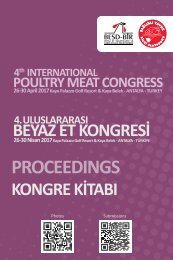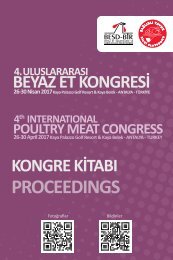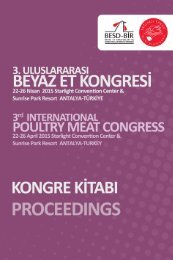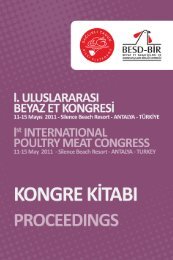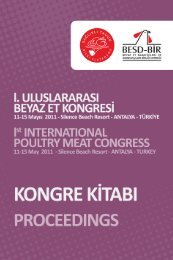3rd International Poultry Meat Congress
Proceedings
Proceedings
Create successful ePaper yourself
Turn your PDF publications into a flip-book with our unique Google optimized e-Paper software.
Table 3. Fatty acid composition of Camelina meal (% of ether extract).<br />
Fatty acids<br />
Amount<br />
Palmitic (16:0) 9.00<br />
Palmitoleic (16:1) 0.20<br />
Stearic (18:0) 2.50<br />
Oleic acid (18:1) 20.20<br />
Linoleic (18:2n-6) 23.40<br />
α-Linolenic (18:3n-3) 29.60<br />
Eicosenoic (20:1) 10.10<br />
Eicosadienoic (20:2) 1.40<br />
Eicosatrienoic (20:3) 1.20<br />
Erucic (22:1) 1.70<br />
<br />
Antinutritional Factors in Camelina Meal<br />
As a member of Brassiacaceae family, Camelina seeds are also expected to contain antinutritive<br />
compounds such as glucosinolates and sinapine. It has been suggested that concentration of<br />
antinutritional compounds in the seed is associated with the genotype of the plant. Glucosinolate<br />
level in Camelina seeds from different genotypes ranges between 15.2 and 24.6 mmol/kg (12).<br />
Aziza et al. (13) also reported similar level of glucosinolate level (24.4 mmol/kg) for Camelina<br />
meal as well. However, another study indicated (Table 4) higher level (34.4 mmol/kg) of<br />
glucosinolate for the Camelina meal (10). It has been suggested that Camelina meal contains<br />
higher concentration of glucosinolates than the seed itself. While seeds of Camelina contains<br />
9-19 mmol/kg of glucosinolates, Camelina meal produced from the same type of seeds contains<br />
14.5-23.4 mmol/kg glucosinolate (14).<br />
Table 4. Glucosinolate level in Camelina meal (mmol/kg).<br />
Items<br />
Amount<br />
9-(methyl-sulfinyl) nonyl (glucoarabin) 9.04<br />
10-(methyl-sulfinyl) decyl (glucocamelinin) 21.59<br />
11-(methyl-sulfinyl) undecyl 3.80<br />
Total glucosinolates 34.43<br />
<br />
Sinapine has been detected in the different plants belonging to Brassicaceae family (15).<br />
Sinapine is the component which imparts bitter taste to oilseeds. Camelina seeds contain 4 mg/g<br />
sinapin (16). Sinapin content of Camelina meal has also been investigated and very different<br />
results (1.7-4.2 mg/g) have been reported depending on the location and growing season of the<br />
seed which is used for oil extraction (14). Condensed tannin level in Camelina meal is lower<br />
than the seed itself and reported between 1.0-2.4 mg/g depending on the sample (14). Camelina<br />
oil is reported to contain 2-4% erucic acid which is higher than the level in canola oil (5).<br />
Effects of Camelina Meal on Broiler Performance<br />
Camelina meal’s effect on broiler performance has been studied (8). Camelina meal constituted<br />
10% of the diet at the expense of soybean meal. Live weight of birds fed on camelina meal was<br />
reported to be lower than the birds in the control group. Reduced feed consumption was reported<br />
for the broilers which had 10% Camelina meal in their diets. Another study (9) has reported<br />
lower feed efficiency with the inclusion of camelina meal in the broiler diet during the first 21<br />
189





